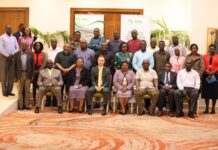By Ayodeji Balogun
Prior to joining a strong mix of professionals and businesses at the 2023 Intra Africa Trade Fair (IATF), I was in Kigali, Rwanda living the reality of a lot of the conversations spotlighted in the course of the week-long event. As is most often the case in our business at AFEX, I was trying to sell maize. Only this time, I was attempting to sell Ugandan maize in Rwanda. We had close to 5,000MT of maize from Uganda, a net positive supplier of the commodity that produces more than it domestically consumes. Rwanda on the other hand imports more around this time of the year to balance its production volumes to meet up with demand requirements. This interplay of comparative advantage in production alongside demand and supply numbers is a fundamental one that makes for the development of beneficial trade relationships, but anyone who knows or has business on the continent would agree when I say things happen differently in Africa.
In this case, a big question that introduced significant friction in sealing an intra-Africa trade deal was one of quality parameters. Uganda produces maize in two seasons, one of which is the rainy season, but lacks post-harvest infrastructure to dry and preserve the quality of the harvest. This leads to aflatoxin formation that often renders commodity shipments rejected at neighboring borders. This is further complicated by a lack of harmonized standards across countries, where Grade 1 or animal feed grade maize mean completely different things as you cross borders on the continent. The eventuality is that countries are forced to look further to satisfy demand requirements rather than simply looking 300km away to buy maize at a good price.
The AfCFTA was the big topic issue at IATF 2023, and although it is hardly a new subject, its core tenets and reason for set-up continue to be a going concern for shoring up Africa’s trade, considering its pivotal role in the transformation of intra-Africa trade. Africa continues to lag behind on intra-regional trade numbers, standing at 13%, in comparison to 66.9% in Europe, 63.8% in Asia & Oceania, and 44.4% in the Americas.
Touted as having the potential to boost intra-Africa trade numbers by 33% and cut the continent’s trade deficit by 51%, the AfCFTA has a major role to play, however delivering on this significant outcome is heavily dependent on the framework’s ability to create a true common economic bloc for the continent, making it easier to trade within itself but also for the rest of the world to trade with Africa.
Innovation around infrastructure continues to be a big part of this puzzle of unlocking the free flow of goods through the region. Africa needs to develop an efficient system to move products across the continent, essentially, developing regional rail belts that connect the major trade corridors. A number of promising plans are in the pipeline including the ECOWAS rail corridor and the trans-Saharan rail corridor, but we need to innovate around unlocking and deploying capital for these heavy infrastructure investments. Another major consideration is one of payments; Africa needs an integrated payment framework that prioritizes ease of transaction between and across member countries. A lot of updates on the Pan-African Payment and Settlement System (PAPSS) came up during IATF 2023, and the reward for getting that right continues to hold immeasurable value for making the vision of one common economic bloc work.
A final important angle is one of trade terms. We have almost every trade in Africa today done on the spot market. We need to evolve that into what is essentially a futures market, where we can agree on terms for future trade today. This creates efficiency, allows us plan as a continent, enables players to more easily unlock financing and better manage risks on both sides. In this vision for the future, Africa should be a price maker not a price taker, and commodities exchanges hold immense potential for making this possible.
In light of these highlighted pathways, the AfCFTA Association of Commodities Exchanges (A-ACX) took flight with the signing of an MoU at IATF 2023. The A-ACX is an association made up of 16 leading commodities exchanges on the continent, which have now all signed on to promote intra-Africa trade in commodities. The contributions that commodities exchanges can make to the aforementioned puzzle pieces for realizing the AfCFTA are quite significant. As core soft infrastructure for establishing and driving market systems, commodities exchanges can work together on strategic initiatives to derisk transactions, drive price discovery and liquidity across markets, unlock financing, and make physical and financial settlements more seamless.
Price fluctuations, logistic barriers, market volatility and numerous other challenges continue to impact intra-Africa trade. The AfCFTA is a gift that we owe future generations as we work to create an economic bloc hinged on inclusion. Commodities exchanges that drive transparent and fairer trade systems can help the cause by providing real-time information and tools that enable African markets to adjust and close gaps. As the A-ACX takes its first steps we envision alongside a more integrated and collaborative African commodities exchange landscape, a future of trade in Africa that is inclusive, transparent and uplifting for Africans.
As I sat on my flight to the next adventure, pondering on the week-long event alongside the new multi-exchange partnership, I was excited for what lay ahead in the coming months for AFEX as we move into Cote D’Ivoire, a more regulated market that is also opening up and attracting investment, and more interestingly, the implications of the A-ACX for the future of West/East African intra-trade, with AFEX at the center.
Ayodeji Balogun is the Chief Executive Officer at AFEX.









